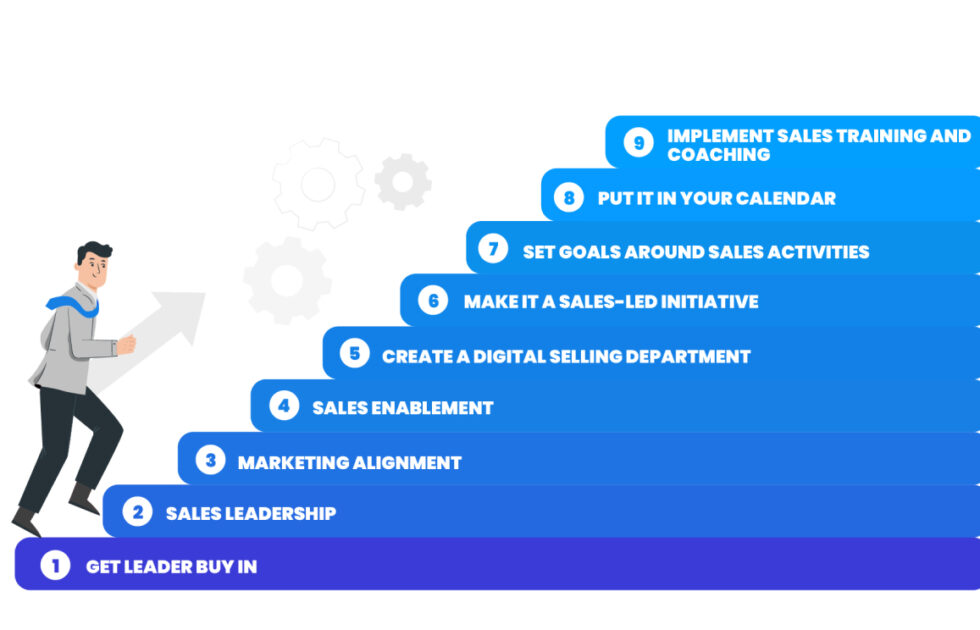Contact
2 Bloor Street West
Suite 700
Toronto, Ontario
M4W 3E2
Canada
support@salesforlife.com Toll-free: (877) 367-9216
Chapter 1
In today’s digital era, consumers are firmly in charge of the buyer’s journey–and they’re demanding that you embrace the digital transformation.
While classic sales tactics like cold calling, broadcasting ads, and email blasts still convert, they’re doing so at a rate that’s decreasing year-on-year.
To sell to today’s modern buyers, sales leaders must take a buyer-centric approach.
“As a salesperson, you need to go to the channel where your customers are now going,” says Amar Sheth, Partner, Customer Experience at Sales for Life. “It’s not that they’re not on the phone or they’re not on email, but they’re not waiting by the phone anymore.”
Instead of being fully reliant on email and phone, sales professionals are now encouraged to complement their cold-calling strategies with social selling campaigns.
After all, people purchase everything from clothes to electronics to food online. They also conduct online research on big-ticket items, from vehicles to vacation packages, before purchasing. What makes you think that they don’t also research software, HR best practices, insurance, or corporate healthcare policies online?
of business buyers conduct more than half of their research online before making a purchase decision
of CEOs and VPs use social media to make purchasing decisions
of sales professionals using social media perform better than their peers

Social selling is the process of developing, nurturing, and leveraging relationships online to sell products or services. It encompasses more than just networking on social media sites: It’s a broader strategy that includes sharing relevant content with leads and prospects online, interacting directly with potential buyers and customers, personal branding, and social listening and surrounding.
Social selling is also not exclusively applicable to the tech industry. In fact, when used alongside traditional sales methods such as email and phone, social selling contributed more than 50% of revenue in several industries.
However, what many sales professionals don’t realize is that social selling cannot be solely confined in a box. In order to be successful, an organization’s social selling efforts must be supported from top to bottom.
Before you proceed, you should first identify where your organization is in the digital transformation process.
“If an organization is thinking about modernizing their sales team, you have to be mindful of what their current state is. Are they already quite a digitally thinking organization, or are they very old-school and more traditional?” explains Brian Lipp, Partner, Growth at Sales for Life.
The sales maturity curve below is a great way to identify where your organization is. According to Lipp, change usually starts within a few individuals experimenting with social methods and having some degree of success. The social selling practices that work eventually get adopted by their whole sales team. With continued success, it eventually becomes a fully operationalized and cross-functional process with full support from top stakeholders.
You have not established with your sales team the mindset that social and digital communication will have a positive impact on the business. There is little to no buy-in from commercial leaders on the effectiveness of social, no social governance, and no formal training on social.
Your company has no formalized social training program, governance, or best practices. Only a small number of sales professionals are meeting their goals via LinkedIn networking.
“Often you’ll see in a sales team the top performers, the people who are meeting quota and hitting their numbers,” says Lipp. “These are the people who are studying their craft: They’re reading books, they’re learning. That’s part of why they’re better at researching the market, mapping relationships, learning how to engage.”
These individuals are the key to scaling up your social selling efforts.
“As a sales leader, take a pulse of your current state, not only from a metrics and goals point of view but also of your actual people,” says Lipp. “Who are the real changers internally? Who are the real people that are willing to learn and stick their necks out for the greater good of the organization?”
You’ve probably done or are doing at least one of the following:
Social selling has increasingly become a priority.
Your frontline sales leaders are driving accountability throughout their sales forces to ensure social actions are reaching the defined measurable milestones.
The digital marketing team is working side by side with sales to fuel the insights (content) that sales professionals will use to engage their buyer.
Social selling is now a by-product of your organization’s effective sales and marketing alignment, and the two teams are formulating new ways to measure success.
You have established an insights committee to further fuel sales conversions.
Everyone in digital marketing and sales is accountable for helping buyers throughout their journey. The marketing and sales teams are generating “team revenue” together.
At this level, it’s imperative that your social selling efforts have full support from your organization’s top executives and stakeholders.
“At the highest level, you have to demonstrate that social selling will help you grow pipeline or improve win rates; commercial performance will be improved,” says Lipp.
“Start with the outcomes. Defend them well, outline that you’ve tailored the outcomes to what their growth priorities are or where they’re trying to go so it becomes infused with the top growth strategy of an organization. Pending that buy-in, you could then show people how to get there or how to do the work to make it happen.”
To succeed in social selling, your organization needs to get rid of the notion that everyone has to stay in their own lanes.
“One of the best things about social selling and digital marketing is that it’s forcing silos to come down,” says Lipp. “People that are doing this well are communicating and working cross-functionally together, tighter than they have before.”
In order to effectively work cross-functionally, the whole company has to adopt a customer-centric mindset. The organization must mandate that the sales, marketing, and operations/enablement leaders are equally part of social selling planning and execution—all for the benefit of your clients.

“Customer-centricity, with transparency and with access to information on the internet, is more important than ever,” says Lipp. “You can no longer be self-serving with your own process, just for your own reasons of profit. You have to build a process that helps customers and in turn, if you do that well, you could build a healthy business.”
You also have to ensure that everyone is educated on the differences between social selling and social media marketing. This way, there would be no confusion between teams.
Social selling and social media marketing are two powerful strategies for driving revenue. However, a lot of people think these two are either interchangeable or are the same thing. Several sales leaders also tend to immediately connect the word “social” to Facebook, Twitter, Instagram and other networking sites, when the word actually pertains to a mechanism to engage people and conduct research.
While social selling and social media marketing are both done on basically the same platforms, their methods and goals are different. Think of social media as a telephone, says Sheth. “There are two people using the telephone for different means. There’s one person using the phone to call a certain person–that’s social media marketing. And another person, social selling, is calling another group of people for different reasons.”
Social media marketing is one aspect of a larger content marketing strategy. It delivers the right content to the right people at the right time.
Social selling, on the other hand, is needed to ensure that your prospects buy from you and not from your competitors. It’s all about establishing relationships with the right people within a buying committee, and involves targeted content marketing, meetings with prospects, and personal branding.
“Social media marketing has to be done to get the broader brand of the company out there, to let people know what the brand is, what the company believes in, their vision, mission, purpose, customer stories, etc., which is one type of advertising,” explains Sheth. “And then social selling is just something that’s done by the revenue-driving team, primarily for the reason of building relationships that ultimately lead to revenue.”
Chapter 2
Social selling should be adopted by as many companies as possible, regardless of industry. But there are still people who doubt its effectiveness, placing their faith in more traditional sales methods—which, as we’ve mentioned earlier, still work, though at a declining rate.
“In 2012, something like 72% of salespeople made quota. Now it’s 56%, and some studies say it’s 46% or 50%,” says Sheth. “So if customers are actually not responding to you, how are you going to make quota?”
Below, we take a look at some statistics that should make a compelling case for social selling.

01
Revenue Growth
61% of organizations engaged in social selling report a positive impact on revenue growth. In many industries, over 50% of a sales representative’s quota is made up of social selling sources or influenced deals, according to empirical data from LinkedIn.
Social selling enables sales professionals to better qualify leads, write bids, and adjust deal renewal language—which has been correlated to 40 to 50% more new business and 80-90% retention rates.

02
Quota Attainment
On average, 67% of sales professionals don’t meet their quotas, according to a study conducted by the TAS group:
Social sellers realize 66% greater quota attainment than those using traditional prospecting techniques.

03
Customer Retention
When your sales professionals can give your existing clients valuable insights, you’ll be better able to retain your current customers and find new business opportunities. As a result, over 33% of a company’s customers are less likely to cancel or churn after the adoption of social selling.

04
Building Relationships
74% of the time, buyers will choose the sales professionals who were first to add value.
Modern buyers demand information to make informed decisions. They’ll only engage with sales professionals who are willing and able to provide insights along their journey. 62% of sales pros at large companies agree social selling helps them build stronger and more authentic relationships.

05
Educating Customers
74% of today’s B2B buyers conduct more than half of their research online before making a purchase.
Today’s buyer is looking for a partner who provides true insight. Don’t sell to them. Instead, educate them. Explain how you have addressed their challenges by using e-books, blogs, tip sheets, and more. When you establish yourself as a helpful expert in the field, your prospects will remember you before making a buying decision.

06
Competitive Advantage
78% of sales pros using social media perform better than their peers. The best-in-class marketing teams align the content they share with marketing/sales funnel stages. Giving your buyers what they want, where they want it, and when they’re ready gives you a huge competitive advantage.
Chapter 3

“Social selling has different definitions for the different parties involved, as each party is measured by very different outcomes. The first step is to ensure that everyone understands what social selling can do for the impact of a business,” says Jamie Shanks, Managing Partner at Sales for Life.
Top-to-bottom digital sales transformation is the first and the most crucial step in social selling integration. The executive team needs to truly believe that social selling will positively impact the business. You also need triple-alignment: the sales, marketing, and sales enablement leaders must all work together.

The Role of the Sales Leader:
With proper sales leadership accountability, a sales
professional will learn a new
skill, and the sales leader will
be responsible for helping to ensure that newly acquired
skill is actioned into a sales outcome.

The Role of the Marketing Leader:
The marketing team must
become the factory that
creates, organizes, helps
expand discovery of and
measures the engagement
of all insights consumed by
your buyers.

The Role of the Sales Enablement Leader:
Makes sure that the sales and marketing teams are working together harmoniously by visualizing and documenting current sales process for both
sales and marketing.
Sales leaders should ensure sales professionals implement social selling into their daily cadence through one-on-one meetings and constant coaching. They should examine learning behavior and translate it into sales outcomes. Most importantly, sales leaders must demonstrate they believe in social selling through their own actions.
“Training and coaching all starts with sales leadership,” says Shanks. “Sales leaders need to understand why they’re doing this, the impact this will have, and how they will drive accountability to their frontline sales managers.
“They will also enable the frontline sales managers to incorporate everything that they’re learning into their one-on-ones.”
According to Forrester’s Report Embrace B2B Social And Meet Buyers On Their Terms, 67% of companies need marketing to support social selling activities with content. Sales professionals rely on the marketing team to create content they can share with prospects that will provide real value. Integrating the sales and marketing departments will result in an influx of new ideas for digital insights.
Sales enablement helps connect the sales and marketing teams and bring them together into one workable system. They find the people, processes, and technology to ensure social selling can be fully integrated into their current sales processes.
The most successful social selling implementations come from progressive enablement teams that have no fear pushing the internal sales status quo. Their enablement leaders know that learning behavior is a leading indicator to future sales success.
Without enablement, there would be no long-term behavioral strategy that will ensure a sustainable cultural shift.
Methods of Alignment
The sales, marketing and enablement departments all fall under the revenue team. As they play an integral role in an organization’s structure, they need to build trust, rapport, and accountability within themselves. Here are some ways to facilitate this.
Once the sales, marketing, and enablement teams are aligned, the next important step is to create a department that concentrates on creating content and research, working alongside sales professionals to help them in their territory. Include a content marketer, a sales development representative, and a sales executive in your digital selling environment.
Rather than marketing on a massive scale, they focus on creating specific content for a specific audience. Together, the digital selling team measures your buyer’s digital footprints and monitors buyers’ content consumption.
A tactical sales leader at the Regional VP or SVP level will drive accountability and bring awareness to the leadership team, the board, and advisors. When the highest echelons of leadership communicate a clear and strong vision, sales professionals will grasp the importance of social selling. Plus, sales professionals will emulate you since they assume your actions are a reflection of what made you so successful.
Shanks emphasizes that the sales team should take the lead in the whole initiative—not the marketing leader, nor the enablement leader. This drives accountability from sales leaders, down to the frontline sales managers and representatives.
“The sales professional reports to the sales managers, who report to the chief sales officer. Only that hierarchy can truly own the program,” Shanks explains. “The marketing function and sales operations and sales enablement are supporting functions of a social selling program…they can only be a part of the buying committee and the steering committee that makes this a reality within the sales organization.”
To ensure that all departments are working towards the same goals, get sales, marketing, and sales enablement leaders to define what success looks like for them. You can first craft a common goal, then create more tactical goals for each individual department. Make sure to set a defined timeline, quantifiable for your goals.
“Recognize that the only things you can control are actions and activities. Everything else is an influence, an alignment to something greater,” says Shanks.
To figure out how to achieve—and exceed—your targets, reverse-engineer your goals. Figure out what you need to do every day, week, and month to get where you need to be.
Set reasonable yet challenging targets around the following:
“That target may be a revenue goal or a volume goal—a deal flow, as an example—and those are called business outcomes, or goals,” continues Shanks. “And these business outcomes, you cannot achieve directly. You can only highly influence them, align with them.”
Your sales actions and activities will impact how you achieve your sales objectives. To see if you’re on track to achieving your desired business outcomes, you need to establish milestones: stages where you should be at during a certain time in order to highly influence your goal.
Here’s another reason for the sales team to take the lead in social selling: Only the sales team knows the right sales actions and can set the right goals in order to achieve the desired business outcomes.
“A common mistake that marketing or enablement teams make is they will create arbitrary actions and activities that they think are important and are aligned to their own goals,” says Shanks. “Marketers will say, ‘I need you to share so much content.’ Enablement will say, ‘I need you to do this.’ None of these are sales actions that highly influence objectives that are aligned with business outcomes.”
Each sales professional should schedule 30 to 60 minutes per day for social selling. During this time, they should have a set of repeatable tasks they can execute that are tied to sales results.
Once it’s part of sales professionals’ routines, social selling activities will be nearly impossible for them to give up.
Sales training and coaching should start from the top.
“The frontline sales managers should have the capability to inspect green flags or the red flags, the right things or the wrong things,” says Shanks. “Being able to coach their sellers, and hold them accountable to those green and red flags—that is the start of every program.”
“Once the sales managers are ready to be an accountability coach and leader, they can then pass on their knowledge into the sellers’ hands to be consumed in bite-sized chunks every week. They learn a skill, apply it in the market, and amplify that skill with other skills.”
With successful one-on-one coaching, you get the results that you measure and coach toward. If you’re constantly reinforcing elements of social selling to go deeper and wider into accounts, expect that social selling will become part of their daily cadence.
Steps for successful coaching:
There’s a lot of internal politics involved in a customer’s buying process. To succeed, sales teams should find and engage with an internal brand advocate who can keep the buying process moving from the inside.
The sales and marketing teams should work together to gather information about the target buyer, sifting through the buyer representatives to get to the actual decision makers. You will need data on their skills, day-to-day activities, and professional goals and challenges, plus their companies’ key business priorities, organizational structure, and more. The output is what you call the ideal customer profile.
How to create an ICP
Using social media is one of the easiest ways to get information about your target buyers. LinkedIn accounts and company profiles can provide a lot of data. Sales leaders can also use the company’s 10-K Report to learn more about its status and outlook.
In some instances, target customers might not be very visible online. A workaround is to use social media to surround your buyers.
“If they’re not overly social, are they mentioned socially online?” asks Sheth. “Find that out first. Then find out about the company using publicly available information. Your company, your target prospects, your current accounts are putting up so much information online. Use that to bring greater relevance and context to your sales process.”

If neither your target buyer nor their company has a strong online presence, you can try learning about the industry that your prospect or target account lives in.
“Know everything about them. Find out what makes them tick, what makes them move, what drives them,” says Sheth. “Use all of this information and package it to power your sales process with one simple goal: Greater relevance and greater context with every interaction.”

The right content can transform ordinary sales professionals into trusted thought leaders and industry experts. Creating a centralized content library aligned with the buyer’s journey and persona not only accelerates the buyer’s education process, but also helps demonstrate subject matter expertise and familiarity with the buyer’s challenges.
In order to produce content that customers want and need, Marketing should bring Sales into the content creation process. The integration of the two teams will also increase the flow of new ideas for digital insights, which drive conversions.
The 4 Pillars of Insight Production

Create
a foundation for developing new insights at scale. This will accelerate depending on how much you invest in people, processes, and technology.

Organize
insights, which need to be exposed to your buyers fast. Use tools to capture and share insights in a seamless motion.

Discover
innovative “guerrilla marketing-like” ways that you grow sales pipeline. Experiment, measure, rinse, and repeat.

Evaluate
every interaction your insights are having with buyers. By compounding these interactions together, you will uncover trends that help you roadmap a prescriptive way to make incremental improvements to your Insights Factory.
Chapter 4
There’s no shortage of material on social selling online. In fact, you don’t really need to hire a company to teach you about it.
But this is why not everyone who tries to integrate social selling into their sales strategies succeeds.
“To learn it in a sequenced and proper chronological manner that has a proven success record, that takes into account time so you’re not spending 2, 3, 4, 500 hours figuring the stuff out—that’s what makes training crucial,” says Sheth.
“Everybody knows what social selling is, but nobody really has given them a standardized method to not only learn, but also to apply it. You want a uniform circular method being followed so that there’s a process.”
When it comes to social selling, you either do it right, or don’t do it at all—and a sales training company can help ensure that you are on the right track.
Here’s what a great sales training program can do for your organization:
Executive buy-in is critical for social selling success. It’s necessary for
reinforcement and support, which then trickles down throughout the entire salesforce. A sales training company should help you convince your sales professionals why social selling works and how it will benefit them. The most successful companies see social selling as one piece of their larger digital selling organization.
Just because your sales people are successful doesn’t mean they’ll be naturally great in a leadership role. They need training too. Additionally, social selling training can become a two-way street. Sales leaders should stay open to learning new techniques from sales people.
To increase adoption levels of social selling, include the sales operations, enablement, and marketing teams in training. Doing so will help embed the new way of selling into your company’s DNA.
Sales professionals spend, on average, 65% of their time on activities other than sales. A sales training company will help you determine which activities your sales reps are spending the majority of their time on. They’ll help address any skills gaps and elevate the performance of your team. The most effective sales teams apply one methodology consistently. Continuous sales training ensures your team members will keep improving, thus boosting your sales effectiveness results.
A sales training company will help you set SMART (specific, measurable, attainable, relevant, and timely) goals that align with your company’s priorities. In addition to allowing you to measure your efforts, setting goals will also motivate your sales people. They can provide your sales reps with a self-service metric dashboard so they can check their individual performance and progress towards goals.
Chapter 5
“A lot of people solve the problem by just buying the tools, as if the tools are going to help solve the problem,” says Sheth.
“For me personally, the challenges that exist in social selling adoption are actually challenges of the human condition, which is not having a proper mindset. This means not acknowledging the problem on purpose or not genuinely being able to identify the problem. Second, not having the courage or the willingness to learn what it takes to solve the problem.”
Once you’ve fixed these two mindset issues, Amar continues, how do you use tools to achieve that?
Sales acceleration happens only when the mindset is shifted first. Oftentimes, the challenge in any organization is the sales teams’ low technology and tool adoption, even social selling tools. Focus on retooling the mindset first before offering any technology to sales.

One of the most important social selling tools you can have in your arsenal is LinkedIn Sales Navigator. It aggregates many of the processes that your sales team has been doing with a regular LinkedIn account, but packages the process for Account-based selling.
The Social Selling Index Score (SSI Score)
A gauge for your team to stack rank team members, and against industry peers. Has a total score of 100 and is weighted equally across 4 areas:
Chapter 6
Get the sales, marketing, and sales enablement leaders together and ask them to define what success looks like for them.
“It all starts with where you’re trying to go,” says Lipp. “Are you trying to grow new business, land new logos, or expand in, say new markets, things like that? Or are you much more focused on protecting renewals and revenue churn, going further and deeper into your existing base?”
From there, you can craft common goals for the whole organization, as well as tactical goals for each department. These goals should be quantifiable: Numbers don’t lie.

Measuring the wrong metrics can cause your social selling efforts to fail. A sales training company can guide you in selecting three levels of indicators:
Behavioral changes that indicate if new learnings are being translated into sales outcomes via tool usage. Here are some examples:
Provides a summary of your efforts in trying to hit major milestones and goals. They help you answer the following questions:
Chapter 7
In order to succeed, your social selling strategy needs a clear action plan.
One-off, “random acts of social” will not get you anywhere—you will need at least 7 to 10 touchpoints over 30 days.
A defined cadence isn’t about barraging a buyer via all mediums, all the time. But it does require you to be fluid and to experiment with different content: Articles, video messages and email templates that include a digital insight attached, voicemail messages leading to a landing page, and so on. What’s important is that you are adding value at every touchpoint.

The SPEAR Selling strategy is an effective way to fill your sales pipeline and prospect more efficiently. First, a seller needs to be accountable for their own territory by visualizing their total addressable market (TAM). This allows them to see clearly where gaps and opportunities lie, and they can apply signal intelligence against accounts in their TAM so they can Select and Prioritize the most promising prospects.
From there, the seller moves on to Planning—developing executive business plans for the top accounts. Engagement starts after, powered by synchronous and asynchronous video.
Next, the seller Activates customers by applying the signal intelligence and the stories they have created against their accounts. The seller should gauge the customers’ feedback—also known as buying intent—before moving to the Reprioritize phase, where in the seller will redevelop their TAM based on all the data they have gleaned.
Chapter 8
When properly taught and applied, social selling can do wonders for a sales team.
“What was really interesting to me in 2020 is that we had over half a dozen customers that had 100% of their team complete their learning,” recalls Lipp.
“If everyone does all their work, obviously most of that work is going to translate into outcomes. And that’s what happened: customers that did well saw significant growth and pipeline, win rates, deal sizes. It also really helped them protect customer churn or revenue churn and drive cross-sell, upsell in organizations.” Brian Lipp, Partner at Sales for Life
Truly, social selling is necessary to survive and thrive in today’s modern sales environment. The sooner you embrace this, the faster you will meet quotas, grow your pipeline, maximize your profitability, and elevate your team’s skills.
As the nature of social media is guaranteed to evolve in the future, continuous social selling training is a crucial investment for any company, future-proofing your pipeline and revenue growth.
Subscribe to receive more sales insights, analysis, and perspectives from Sales For Life.

